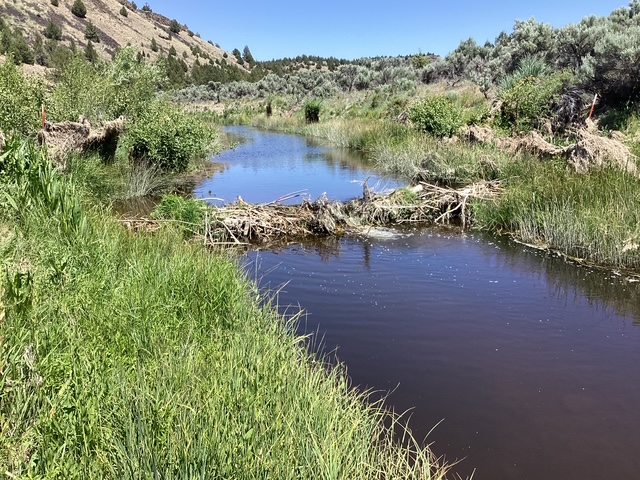Sports
Beavers Return to South Fork of Crooked River After Over a Century

Beavers are making a significant comeback along the South Fork of the Crooked River in Oregon, after an absence of more than a century. A family of beavers, consisting of two adults and two young, known as kits, has been spotted actively building dams in the area. This resurgence is being hailed as a vital step towards ecological restoration, according to the Oregon Natural Desert Association (ONDA).
Historical Context and Ecological Impact
For thousands of years, beavers played a crucial role in shaping the landscape along the Crooked River by constructing dams that redirected water through wetlands and meadows. Their populations dwindled significantly after European trappers arrived in the early 1800s, leading to a sharp decline due to the lucrative beaver pelt trade. Following this decline, the land underwent substantial changes as settlers established ranches, further degrading the natural habitat and causing water quality to suffer.
Efforts to restore this vital ecosystem have gathered momentum in recent years. Jefferson Jacobs, the riparian restoration manager with ONDA, noted that habitat management projects have made the land more conducive for beavers, enabling their return after a long hiatus. “They haven’t been living on that section of the river from year-to-year, and reproducing, for over a hundred years—up to 200 years,” Jacobs stated.
Restoration Efforts and Beavers’ Role
The beavers have started to make their mark on the river, with their dam-building activities already altering the landscape. ONDA has been conducting habitat restoration on a privately-owned stretch of land along the lower end of the South Fork of the Crooked River. This initiative began in 2014 and involved fencing off the area to protect it from grazing livestock, allowing native vegetation to flourish.
Jacobs explained that decades of agricultural practices had stripped the landscape of essential vegetation, which beavers need for food and dam construction. Tens of thousands of trees and plants have been introduced to the area, and it has taken time for this vegetation to mature to a size attractive to the returning beavers. “They were always passing through but kept on going because it was horrible habitat. There wasn’t anything for them to eat in winter once the grasses and flowers had died off,” he said.
In an unexpected turn of events, a flood earlier this year damaged ONDA’s fencing, allowing a pair of beavers to establish themselves and successfully raise two kits. Jacobs highlighted this success as a positive indicator of the ecological restoration efforts: “That is a real metric for success.”
Importantly, Jacobs confirmed that these beavers migrated to the area naturally, without human intervention. Their return is viewed as a potential catalyst for improving the water quality of the river, which has suffered from historic overgrazing.
Interest in similar habitat restoration projects has increased among other landowners and managers. Jacobs indicated that plans are underway for additional projects across various stretches of the South Fork, with the aim of establishing between 15 and 40 breeding beaver families along the river.
The return of beavers to the area is not only a success story for local conservation efforts but also reflects wider trends in ecological restoration. Following the completion of a significant restoration project on Whychus Creek in 2024, beavers also returned to that area, demonstrating that such initiatives can yield positive results.
-

 Lifestyle3 months ago
Lifestyle3 months agoLibraries Challenge Rising E-Book Costs Amid Growing Demand
-

 Sports3 months ago
Sports3 months agoTyreek Hill Responds to Tua Tagovailoa’s Comments on Team Dynamics
-

 Sports3 months ago
Sports3 months agoLiverpool Secures Agreement to Sign Young Striker Will Wright
-

 Lifestyle3 months ago
Lifestyle3 months agoSave Your Split Tomatoes: Expert Tips for Gardeners
-

 Lifestyle3 months ago
Lifestyle3 months agoPrincess Beatrice’s Daughter Athena Joins Siblings at London Parade
-

 World2 months ago
World2 months agoWinter Storms Lash New South Wales with Snow, Flood Risks
-

 Science3 months ago
Science3 months agoTrump Administration Moves to Repeal Key Climate Regulation
-

 Business3 months ago
Business3 months agoSoFi Technologies Shares Slip 2% Following Insider Stock Sale
-

 Science3 months ago
Science3 months agoNew Tool Reveals Link Between Horse Coat Condition and Parasites
-

 Science2 months ago
Science2 months agoSan Francisco Hosts Unique Contest to Identify “Performative Males”
-

 Sports3 months ago
Sports3 months agoElon Musk Sculpture Travels From Utah to Yosemite National Park
-

 Science3 months ago
Science3 months agoNew Study Confirms Humans Transported Stonehenge Bluestones








